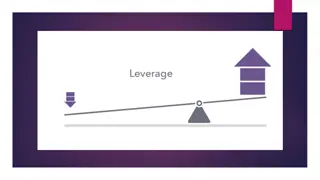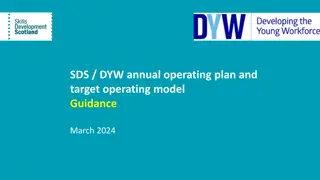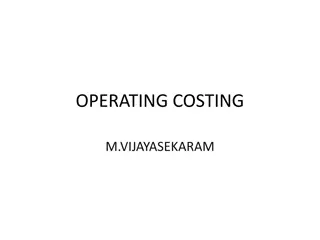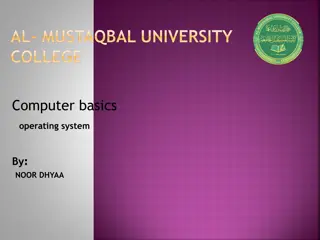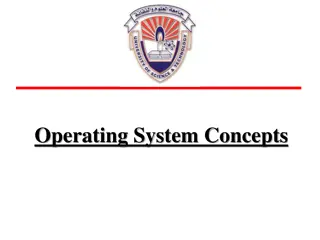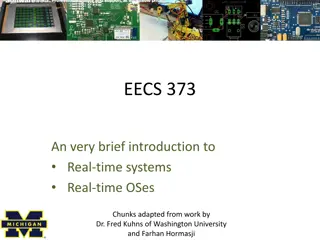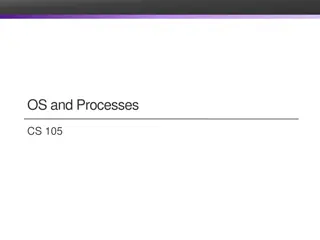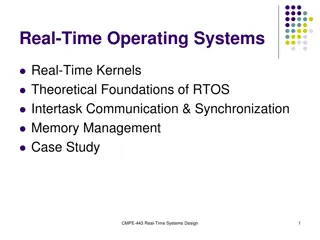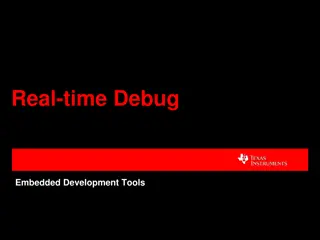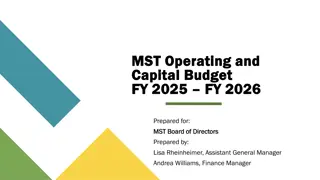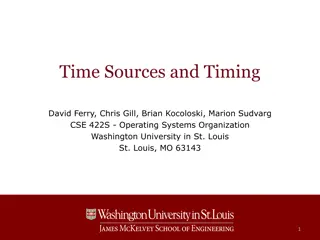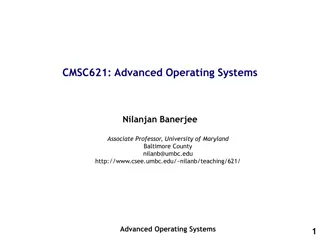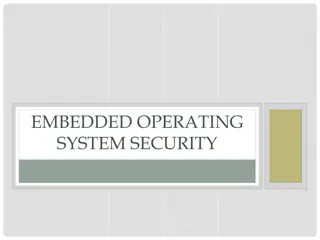Understanding Real-Time Systems and Operating Systems
Real-time systems in computing refer to the concept of task execution meeting specific deadlines, with examples including process control in industrial plants, robotics, air traffic control, and more. Tasks in real-time systems have defined release, schedule, completion times, and deadlines, with runtime being the uninterrupted time taken for task completion. This overview covers hard and soft real-time tasks, types of real-time tasks, and key terms and definitions in real-time scheduling.
Download Presentation

Please find below an Image/Link to download the presentation.
The content on the website is provided AS IS for your information and personal use only. It may not be sold, licensed, or shared on other websites without obtaining consent from the author. Download presentation by click this link. If you encounter any issues during the download, it is possible that the publisher has removed the file from their server.
E N D
Presentation Transcript
CS6456: Graduate Operating Systems Brad Campbell bradjc@virginia.edu https://www.cs.virginia.edu/~bjc8c/class/cs6456-f19/ 1
What does Real Time mean? In computing broadly Real time = the time measured by a physical clock Real time operation generally means the execution keeps up with the pace of events A speech or video sample of 1 second, if processed in 1 second or in less In real time systems Task execution meets specific deadlines 2
Real Time Operating System Real Time Tasks Process control in industrial plants Robotics Air Traffic control Telecommunications Weapon guidance system e.g. Guided missiles Medical diagnostic and life support system Automatic engine control system Real time data base Mars Rovers Curiosity : OS VxWorks, Processor BEA s RAD 750 3
Terms and definitions Release time (or ready time): This is the time instant at which a task(process) is ready or eligible for execution Schedule Time: This is the time instant when a task gets its chance to execute Completion time: This is the time instant when task completes its execution Deadline: This is the instant of time by which the execution of task should be completed Runtime: The time taken without interruption to complete the task, after the task is released 4
Today Intro to real time systems and real time scheduling Hardware support Mixed criticality systems 5
Soft and Hard Real Time tasks Hard real time task: Task must complete before or at deadline. Value of completing the task after deadline is zero. Software real time Missing deadline incurs a penalty Penalty increases as tardiness increases 7
Examples Types of Real Time Tasks Hard Real-time task Air traffic control Vehicle subsystems control Nuclear power plant control Soft Real-time Task Multimedia transmission and reception Networking, telecom (cellular) networks Web sites and services Computer games. Firm Real Task Periodic Task Aperiodic Task Sporadic Task Preemptible/Non-Preemptible Tasks 8
Scheduling concerns Scheduling in Real time in operating systems: No of tasks Resource Requirements Release Time Execution time Deadlines Examples: Rate Monotonic Algorithm Earliest Deadline First Algorithm 9
RTOS Scheduling Classification Real Time Scheduling Off-line On-line Static Priority Dynamic Priority Pre- Non Pre- emptive Planning Based Best Effort emptive 10
Off Line Scheduling (Pre runtime scheduling) Generate scheduling information prior to system execution (Deterministic System Model) This scheduling is based on: Release time Deadlines Execution Disadvantage: Inflexibility, if any parameter changes, the policy will have to be recomputed 11
On-Line Scheduling Number and types of tasks, associated parameters are not known in advance. Scheduling must accommodate dynamic changes Online Scheduling are of two types: Static Priority Dynamic Priority 12
Real-Time Scheduling Real-time tasks execute repeatedly (usually are periodic) under some time constraint Task Task Task Time 0ms 5ms 10ms E.g., a task is released to execute every 5 msec, and each invocation has a deadline of 5 msec Separate priority range from the nice priorities for CFS: Priorities are from 1 (low) to 99 (high), highest ones need root 13
Conflicts with traditional kernel scheduling Deadlines vs. fairness For example, if a user accessed the kernel: can you guarantee my task will run for 1 second at every 5 second interval? Challenges: Linux uses proportional sharing so the answer is highly dependent on other system activity What if another process boosts its priority? What if another process is starved? 14
Real-Time OS Support Goal is to achieve predictable execution: Ideal: Real world: Preemp t Migrate Other sources of uncertainty (and solutions): Interrupts (can mask some interrupts) Migrations (can pin tasks to cores) OS latency, jitter, and kernel non-preemptibility (real-time scheduling) 15
Five real-time scheduling classes First-in, First-out scheduling Round robin scheduling Preemptive fixed priority scheduling Most frequent first Earliest deadline first 16
FIFO Scheduling First-in, First-out scheduling The first enqueued task of highest priority executes to completion A task will only relinquish a processor when it completes, yields, or blocks Task 1 Task 2 Task 3 Time Only a higher priority SCHED_FIFO or SCHED_RR task can preempt a SCHED_FIFO task all others will be starved as it runs 17
Round Robin Scheduling Round-robin scheduling Same as SCHED_FIFO but with timeslices Among tasks of equal priority: Rotate through all tasks Each task gets a fixed time slice Task 1 Task 2 Task 3 Task 1 Task 2 Task 3 Task 1 Task 2 Task 3 Time Only a higher priority SCHED_FIFO or SCHED_RR task can preempt a SCHED_FIFO Tasks of equal priority preempt each other after timeslice expiration 18
Preemptive Fixed Priority Scheduling High Priority Task Time Low Priority Task 19
Preemptive Fixed Priority Scheduling High Priority Task Time Low Priority Task 20
Preemptive Fixed Priority Scheduling High & low priority jobs arrived together arrived together High & low priority jobs High Priority Task Time Low Priority Task 21
Preemptive Fixed Priority Scheduling High priority job is executed first High Priority Task Time Low Priority Task 22
Preemptive Fixed Priority Scheduling High Priority Task Low priority job is executed later Time Low Priority Task 23
Preemptive Fixed Priority Scheduling High Priority Task High priority job arrived Time Low Priority Task 24
Preemptive Fixed Priority Scheduling Preempts low priority job High Priority Task Time Low Priority Task 25
Preemptive Fixed Priority Scheduling High Priority Task Lower priority job resumes later Time Low Priority Task 26
Preemptive Fixed Priority Scheduling High Priority Task Time Low Priority Task 27
Preemptive Fixed Priority Scheduling High Priority Task Time Low Priority Task 28
Rate Montonic Scheduling A priority is assigned based on the inverse of its period Shorter periods = higher priority Longer periods = lower priority P1 is assigned a higher priority than P2. 29
EDF Scheduling Earliest Deadline First (EDF)scheduling Simple, yet effective Whichever task has next deadline gets to run Deadline: 5 Exec time: 4 Deadline: 8 Exec time: 3 Deadline: 12 Exec time: 2 Task 1 Task 2 Task 3 Theory exists to analyze such systems Task 1 Task 2 Task 3 Time 0 5 8 12 31
The ARPA-MT Embedded Project Focuses on providing specialized, time predictable, power efficient systems for hard real time systems Uses a multiprocessor based implementation Design process focused on WCET determinism, task scheduling and resource assignment Xilinx XC3S1500 Spartan-3 FPGA used in implementation Oliveira, A. S. R.; Almeida, L; Ferrari, A. B.; , "The ARPA-MT Embedded SMT Processor and Its RTOS Hardware Accelerator," IEEE Transactions on Industrial Electronics 33
Increasing Execution Time Determinism Uses a simple pipelining for instructions from each task and avoids complex superscalar techniques Simultaneous task execution using SMT Fine-grained time sharing of the processor Interleaving order of issued instructions from tasks reduces global processor stalls caused by data and control hazards Increasing processor availability by reducing context switching and operating system overhead using an Operating System Co-Processor Insight: push scheduling logic into hardware 34
The ARPA-MT Processors Three Processors: Design based off the MIPS32 architecture using SMT Focus will be on Co-Processor-2 CPU MIPS32 Co-Processor-0 Co-Processor-2 Integer instruction set Memory manager RTOS hardware support Exception Processing Uses the five tradition pipeline stages (IF, ID, EX, MA, WB) High resolution real- time clock Interrupt handling 35
Co-Processor-2: The Task Handling Unit All tasks are managed by a module called the Task Handling Unit The Task Handling Unit performs the following: Task handling Implementation of specialized instructions Scheduling Dispatching Management of interrupts Timing constraints verification Table storage for task parameters (TCB) 37
Co-Processor-2: Time & Event Management A task can be event or time triggered The Real-time Clock Unit Generates periodic events assigned by the programmer Triggers other scheduled tasks (most likely garbage handling) External events are managed again by the Task Handling unit 39
Real time systems: all about guarantees A lot of real time scheduling is based on assumptions Periodic tasks Known priorities Known runtimes What happens when we don t know how long something will execute? Runtime can vary Still want to meet deadlines Mixed criticality embraces this uncertainty 44
Mixed Criticality - The Vestal Model Introduces the notion that confidence in a software task s Worst Case Execution Time (WCET) C is proportional to its criticality Higher criticality. Higher analysis effort. More pessimistic WCET CA CB CC CD CE Focusing on a dual criticality system academic works and models that build off Vestal s seminal work essentially treat each task as having a WCET for each criticality High DAL tasks => CHI andCLO Low DAL tasks => CLO The question is how to utilise the spare execution time [CHI - CLO] 45
Mixed Criticality intuition Sometimes requires this much time Typically only requires this amount of time However we don t want to be wrong, so we say it needs this much time Task 1 Time The longer the difference here, then implicitly the higher the criticality 46
LO and HI criticality modes Ci(LO): Max. observed execution time (system designers). Ci(HI): Upper-bounded execution time (static analysis). 47
Robust Mixed-Criticality Normal mode F hi-criticality tasks can exceed CLO Resilient mode Up to M tasks can exceed CLO Each robust task can skip up to S jobs High-criticality mode Low-criticality tasks are not released On an idle tick the counters for jobs skipped (JF) are reset If CHi is exceeded then there is a power cycle 49
Robust Mixed Criticality A robust task is one that can safely drop a non-started job A fault is measured when one task overruns its CLO JF Records the number of Job Failures An error is registered when one or many tasks fail to comply with their timing requirements A resilient system is one which employs graceful degradation (if necessary through the control of robust tasks) in order to cope with one or many faults, thus aiming to avoid errors. 50
RTOS Publications time 51


